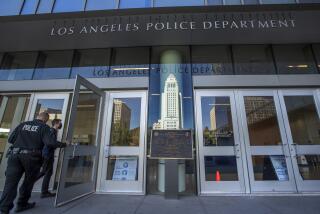Officer Believed He Was About to Be Shot
- Share via
The Oct. 28 shooting of Anthony Dwain Lee is a tragedy for many people, principally the victim, but also his family, friends and the police officer who shot him.
As one would expect, the usual ill-informed accusations are being thrown at the police. Even charges of racism are being raised because the victim was black, notwithstanding the fact that the police officer involved is also black.
These accusations are misplaced.
We all know that the management of the Los Angeles Police Department leaves a lot to be desired and that it repeatedly fails to provide the support and guidance to its rank and file that it needs and deserves. Yet all the noise about that and everything else obscures the fact that was the most important for the two men involved: One of them pointed an apparently real semiautomatic gun at the other.
As we all now know, the “gun” was visually an exact copy, a type allowed on movie and TV sets but, under local and state laws, illegal to brandish. So unfortunately, Lee didn’t just defy common sense, it appears that he broke the law.
For a police officer in the field, each day is laden with fear and doubt. Many situations could end in death. The fear of never seeing one’s loved ones lives in the heart of a Los Angeles police officer as closely as the gun on his or her hip.
Few people can know what it’s like to have to make a split-second decision on which one’s life may depend. When someone suddenly points a gun at you, you can never be 100% sure that they intend to kill you. Police officers are trained to make as balanced a judgment as possible, but it must be immediate. They must not shoot without making that judgment, even though even a fraction of a second’s delay could cost them their lives.
The public criticism in the wake of the Halloween party shooting of Lee does not change the facts. Brandishing a gun, even a replica, even in fun, is never prudent. Police know that replicas are not just used on movie sets. They find their way into the hands of bank robbers, kidnappers and rapists. They are not to be treated lightly because people use them to commit crimes.
The fact is, if the gun had been real and Officer Tarriel Hopper had hesitated, he could be dead. Under life-threatening conditions, waiting for the other gun’s muzzle flash could mean an officer would not live to decide whether to use deadly force. A police officer is not required by law to wait to even see a gun before he discharges his or her firearm in self-defense.
Officers who are shooting to stop the actions of a suspect are required to continuously assess the threat throughout the event, and when, in their opinion, the threat is stopped they must “de-escalate” their force. Whether it is determined after the fact that the suspect actually was pointing a gun at an officer does not invalidate the officer’s actions, based upon the reasonable belief that he was about to be shot.
Every time an LAPD officer shoots at someone, hit or miss, a series of investigations take place. Most of the time, this goes unreported, but careful analysis of these incidents within the department helps police specialists learn and train officers even better so as to decrease the risk of harm to both suspects and police officers in the future.
So the real question here is, did Hopper have a reasonable belief that he was about to be shot? We suggest that when a gun is pointing at you, a gun that is so realistic it is illegal to brandish it outside a movie or TV set, that can create a reasonable belief that you will be shot.
Today, we all grieve for Anthony Dwain Lee and for his family. On many other days, we grieve for fallen officers. Sadly, when officers die in the course of their duty protecting the residents of Los Angeles, the media and many organizations that are so vociferous now are often silent about that officer’s fate and the circumstances that caused it.
More to Read
Sign up for Essential California
The most important California stories and recommendations in your inbox every morning.
You may occasionally receive promotional content from the Los Angeles Times.










